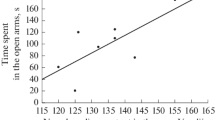Post-traumatic stress disorder (PTSD) develops as a delayed consequence of psychological trauma and is accompanied by characteristic changes in the levels of biogenic amines. The aim of the present work was to carry out a complex study of the dynamics of changes in measures of behavioral activity and noradrenaline and dopamine contents taking cognizance of the activity of the enzyme metabolizing them, i.e., monoamine oxidase A (MAO-A), and the level of the inhibitory transmitter GABA in PTSD. PTSD was modeled in Wistar rats using cat odor. Behavioral changes were studied in the elevated plus maze test. Contents of GABA and catecholamines were determined, along with MAO-A activity levels. The development of poststress anxiety was found to be linked with changes in neurotransmitter levels in the brain. The onset of anxiogenic disorders was preceded by an anxiolytic phase, associated on day 3 with an increase in the GABA level and on day 7 with a decrease in the noradrenaline level in the brain. Only on day 10 was an increase in the noradrenaline content seen, this being synchronized with increases in anxiety. Thus, a significant relationship between the development of behavioral signs of PTSD and an increase in noradrenaline content in the brain was identified.
Similar content being viewed by others
References
I. P. Ashmarin, N. D. Eshchenko, and E. P. Kazeeva, Neurochemistry and Diagrams and Tables, Ekzmen, Moscow (1996).
D. A. Zhukov, The Biology of Behavior: Humoral Mechanisms, Rech, St. Petersburg (2007).
A. Sh. Zaichik and L. P. Churilov, Basic General Pathology, Elbi, St. Petersburg (1999).
V. S. Kamyshnikov, Handbook for Clinical Biochemical Studies and Laboratory Diagnosis, MEDpress-inform, Moscow (2009).
M. V. Kondashevskaya, V. E. Tseilikman, E. B. Manukhina, et al., “Correlation between behavioral manifestations and morphofunctional changes in the adrenals on modeling post-traumatic stress disorder syndrome in Wistar rats,” Ros. Fiziol. Zh., 103, No. 7, 808–818 (2017).
V. I. Kulinskii and G. V. Mikhel’son, “Receptor mechanisms of the neuroprotector effects of GABAergic substances,” Byull. Eksperim. Biol. Med., 125, No. 2, 162–164 (1998).
F. Z. Meerson, Adaptation, Stress, and Prophylaxis, Nauka, Moscow (1981).
T. A. Moskvitina and N. I. Solov’eva, “Physiological importance of amine oxidases and methods of estimating their activity “Klin. Lab. Diagnost., No. 1, 3–6 (2011).
V. N. Orekhovich, Contemporary Methods in Biochemistry, Meditsina, Moscow (1977).
J. Tepperman, and H. Tepperman, “Metabolic and Endocrine Physiology [Russian translation], Mir, Moscow (1989).
R. Adamec, A. Holmes, and J. Blundell, “Vulnerability to lasting anxiogenic effects of brief exposure to predator stimuli: sex, serotonin and other factors-relevance to PTSD,” Neurosci. Biobehav. Rev., 32, No. 7, 1287–1292 (2008).
H. Cohen, J. Zohar, and M. Matar, “The relevance of different response to trauma in animal model of posttraumatic stress disorder,” Biol. Psychiatry, 53, No. 6, 463–473 (2003).
V. J. Glover, “Function of endogenous monoamine oxidase inhibitors (tribulin),” Neural. Transm. Suppl., 52, 307–13 (1998).
P. W. Gold, “The organization of the stress system and its dysregulation in depressive illness,” Mol. Psychiatry, 20, No. 1, 32–47 (2015).
M. Grünewald, S. Johnson, D. Lu, et al., “Mechanistic role for a novel glucocorticoid-KLF11 (TIEG2) protein pathway in stress-induced monoamine oxidase A expression,” J. Biol. Chem., 287, No. 29, 24195–24206 (2012).
B. H. Harvey, F. Oosthuizen, L. Brand, et al., “Stress-restress evokes sustained iNOS activity and altered GABA levels and NMDA receptors in rat hippocampus,” Psychopharmacology (Berlin), 175, No. 4, 494–502 (2004).
C. Heim and C. B. Nemeroff, “Neurobiology of posttraumatic stress disorder,” CNS Spectr., 14, No. 1, Suppl. 1, 13–24 (2009).
Z. J. Huang, “Activity-dependent development of inhibitory synapses and innervation pattern: role of GABA signalling and beyond,” J. Physiol., 587, No. 9, 1881–1888 (2009).
J. Krystal and A. Neumeister, “Noradrenergic and serotonergic mechanisms in the neurobiology of posttraumatic stress disorder and resilience,” Brain Res., 1293, 13–23 (2009).
R. Kvetnansky, E. L. Sabban, and M. Palkovits, “Catecholaminergic systems in stress: structural and molecular genetic approaches,” Physiol. Rev., 89, 535–606 (2009).
A. E. Medvedev, and V. Glover, “Tribulin and endogenous MAOinhibitory regulation in vivo,” Neurotoxicology, 25, No. 1–2, 185–192 (2004).
R. Pitman, A. Rasmusson, K. Koenen, et al., “Biological studies of post-traumatic stress disorder,” Nature Rev. Neurosci., 13, No. 11, 769–787 (2012).
G. Ronzoni, A. Del Arco, Mora F, and G. Segovia, “Enhanced noradrenergic activity in the amygdala contributes to hyperarousal in an animal model of PTSD,” Psychoneuroendocrinology, 70, 1–9 (2016).
Author information
Authors and Affiliations
Corresponding author
Additional information
Translated from Rossiiskii Fiziologicheskii Zhurnal imeni I. M. Sechenova, Vol. 104, No. 2, pp. 156–163, February, 2018.
Rights and permissions
About this article
Cite this article
Tseilikman, V.E., Lapshin, M.S., Komel’kova, M.V. et al. Dynamics of Changes in GABA and Catecholamines Contents and MAO-A Activity in Experimental Post-Traumatic Stress Disorder in Rats. Neurosci Behav Physi 49, 754–758 (2019). https://doi.org/10.1007/s11055-019-00797-x
Received:
Revised:
Published:
Issue Date:
DOI: https://doi.org/10.1007/s11055-019-00797-x



